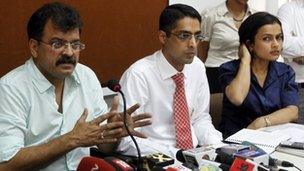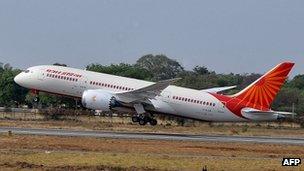Air India: Problems run deep in India's national airline
- Published

Various strikes over the past few years have hurt the airline's reputation among customers
India's national carrier Air India has rarely been out of the headlines - but mostly for the wrong reasons.
Financial difficulties or simmering disputes with staff are a recurrent issue with the airline.
This week, <link> <caption>disruption continued</caption> <url href="http://www.bbc.co.uk/news/world-asia-india-18055260" platform="highweb"/> </link> as staff staged a protest over training opportunities.
About 200 pilots collectively called in sick for work - resulting in a number of international cancellations from Mumbai and Delhi.
The airline is severely in debt and the government recently approved a debt -restructuring plan worth nearly $6bn (£3.8bn).
The civil aviation minister has already threatened to pull the rescue plan and shut down the airline if the pilots continue their protest.
While some of the problems that the airline faces - such as high fuel costs and tough competition - are common to other companies in the sector, Air India also has a unique problem that is now being seen as the root of its downfall.
That is the unhappy merger of two entities - <link> <caption>Indian Airlines and Air India back in 2007.</caption> <url href="http://news.bbc.co.uk/1/hi/business/6264883.stm" platform="highweb"/> </link>
But there have been problems of integration ever since. Recently, even Civil Aviation Minister Ajit Singh admitted that the merger had not worked out as planned.
From a market share that was once above 60%, the merged company now has just a 17% share of the market.
Unions at loggerheads
Over the years, as private competition built up, the airline has steadily lost both its passenger and cargo traffic.
Even today, the government admits that the merger is only 70% complete.
Human resources is still not a common department, resulting in disparity in pay scales, allowances and career progression.
And that is at the heart of the latest dispute between Air India's management and pilots.

Tauseef Mukadam (c) and other IPG officials talk to the media, who are following the dispute keenly
There are two strong unions representing pilots from the erstwhile companies, and they are still at loggerheads.
One is the Indian Pilots' Guild, representing Air India employees, and the other is the Indian Commercial Pilots' Association for pilots from Indian Airlines.
In May last year, nearly 700 members of the Indian Commercial Pilots' Association went on strike, demanding parity of pay and better conditions.
They alleged that their colleagues on international routes earned up to $4,500 a month more than them.
The striking pilots were from the former Indian Airlines and were allowed to fly mainly domestic routes while the Air India pilots flew mainly international routes.
That meant the latter group received added incentives like international allowances, stay and other benefits.
Now it is the other way round. Staff from the Indian Pilots' Guild, representing pilots from the Air India faction, are striking.
This time it is about who gets to fly which aircraft.
Contentious Dreamliner
The companies historically had preferred to fly planes from two different makers.
While Air India preferred Boeing, Indian Airlines ordered from Airbus.
Pre-merger, Indian Airlines had placed orders for more than 40 Airbus aircraft while Air India had ordered 50 from Boeing.
When the delivery of the new planes began, the Boeings came first and only pilots of the erstwhile Air India were allowed to fly them.
Now more Boeings are being delivered and the 787 Dreamliner is the bone of contention. The management proposed that both factions be given equal opportunities in training to fly the Dreamliner.
But about 440 pilots, who mainly fly international routes, have been demanding their colleagues from former state-owned partner Indian Airlines should not be trained to fly Dreamliners, as it may hurt the career prospects of original Air India staff.
Employees from the Indian Pilots' Guild say that since they already fly Boeing, they will require less time to be retrained to fly the 787.
Captain Tauseef Mukadam, from the Indian Pilots' Guild, says: "For an Airbus pilot to train on Boeing, it takes nearly six months and costs at least 10m rupees ($185,000; £115,000). But for a Boeing pilot to train on a Boeing 787, the cost is less than 3m rupees and the time taken is two months.
"Now when the company is going through losses, how can they justify this kind of expenditure?"
Flying the Dreamliner will also have added perks, including travel allowances and promotions.
The management has responded by derecognising the Indian Pilots' Guild and sacking many pilots.
But many think the industrial action has come at a particularly bad time.
Industry in debt
Five of India's six main carriers are losing money. Low-cost carrier Indigo is the only profitable airline in the country.
The industry has a combined debt of nearly $20bn.

The latest strike by Air India pilots is over differences in training for Boeing 787 planes
But employees point out that both Air India and Indian Airlines were profitable companies prior to the merger.
Now the company is in severe debt and owes billions of rupees to fuel suppliers.
In a bid to raise more money, the government is also looking at selling off some of the airline's assets, such as property, and letting go of parking spots at airports.
Recently, the civil aviation minister questioned whether India needed a national carrier any more.
The ministry is also in the process of implementing the Dharmadhikari committee report, which was set up to look at the core problem of HR and ways to achieve better integration between the two factions.
The government will need to take tough decisions if the recommendations are to be implemented.
Experts believe that Air India will be downsizing its operations. Some of the big loss-making routes, especially internationally, are already being shut down.
That will mean cutting its substantially large staff strength and further troubles internally.